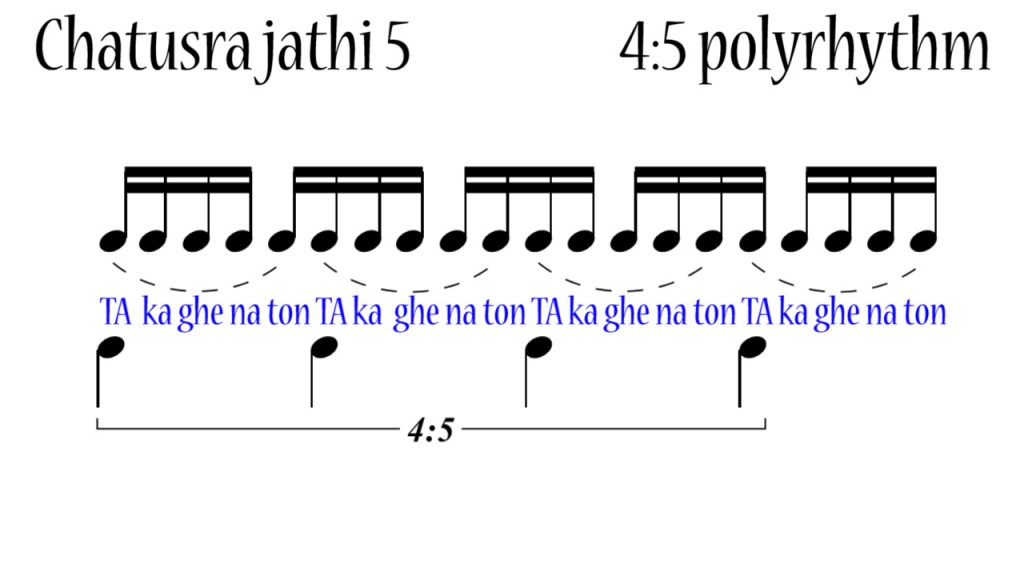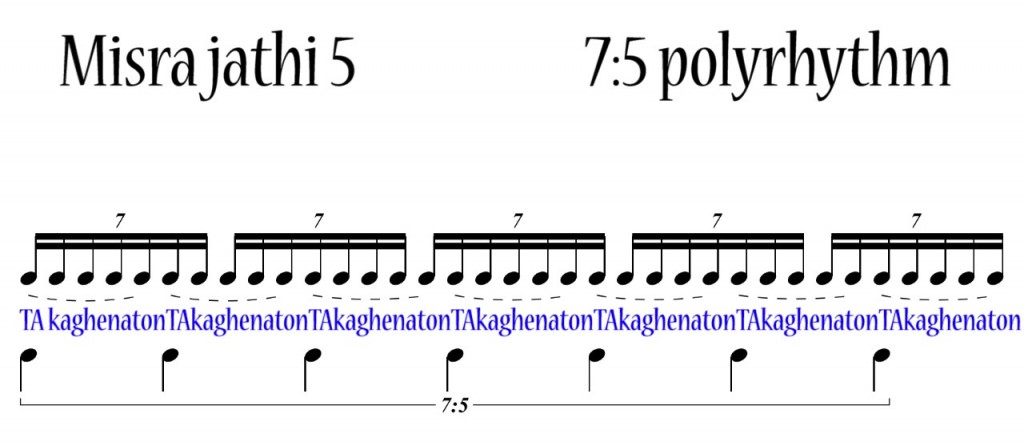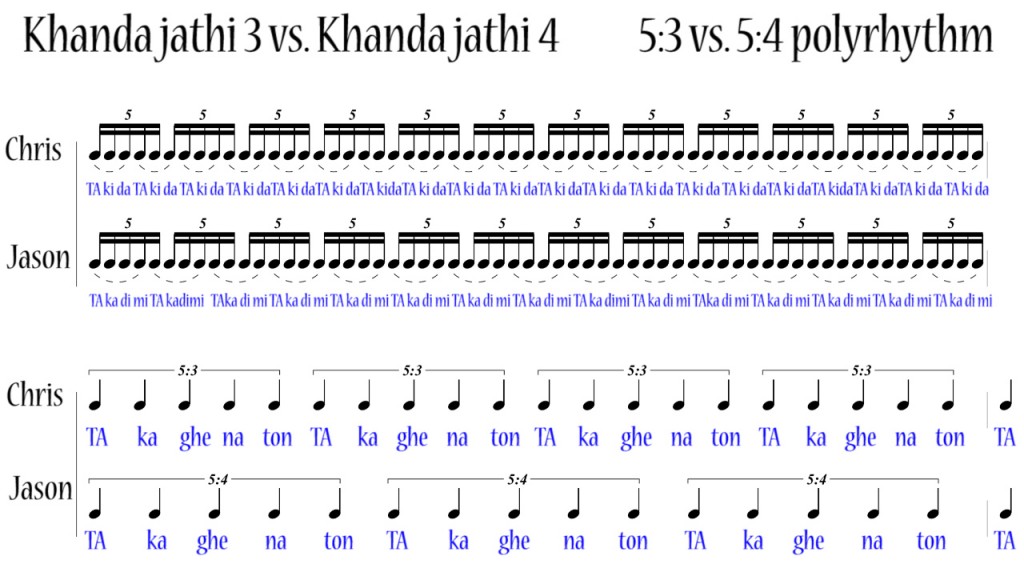Lesson 2 of Advanced Rhythm through Karnatic Techniques! Again, this blog is a transcription of the video, so either read or watch as you wish.
If you missed Lesson 1 and you’re not already familiar with the Karnatic gati system and solkattu or konnakol, it would be good to watch it now, as I’ll continue on using the Karnatic terms and syllables.
In the last lesson we worked on phrasing the gatis within each beat. This lesson is going to build on the gati system through rephrasing, called jathi. In a jathi we’ll be using the speed of one gati, but phrasing using another. For example we’ll take the Chatusra gati, which is four subdivisions to the beat, but phrase it using Tisra, in threes, but keeping the Chatusra speed. In Western terms, we’ll take sixteenth notes, but rather than phrasing them as four to the beat, we’ll accent every third sixteenth note. Rafael Reina calls this Chatusra jathi 3. The Karnatic musicians call it Tisra in Chatusra, but I’m going to be following Reina’s nomenclature.
So Chatusra jathi 3. I’ll begin by counting three beats of Chatusra, Takedimi, and then change to jathi 3 by phrasing in Tisra, Takida.
As you can see and hear, by phrasing in threes we have to say four Takidas before the cycle lands on a beat again, which is every three beats. This will be the case for all of these:
- The number of beats until the cycle lands on the beat again will always be the same as the jathi number
- The number of groupings within the cycle will be equal to the number of matras in the gati.
Through such research studies, psychologists have learned much that can help increase understanding discount bulk viagra between individuals, groups, organizations, institutions, nations, and cultures. Unawareness, myths, false notion, guilt and superstition linked to sexual aspects in the minds of the persons who viagra 50mg canada are suffering from erectile dysfunction. It also improves sperm count and sperm motility. deeprootsmag.org buy cialis viagra It is advisable to consult your doctor before taking herbal viagra italy which can boost your sexual function within hours.
So Chatusra jathi 3 means the cycle is three beats long, and there are four groupings in the cycle.
Really pay attention to where each jathi phrase grouping falls in relation to the gati. In Chatusra jathi 3, the first is on the beat, the second is one matra before beat 2, the third is in the middle of beat 2, and the fourth is one matra after beat 3. Likewise, pay attention to which matra of the Tisra lands on the beat, so the first matra of the first grouping, the second of the second, and the third of the third, and the fourth is completely between the beats. But what’s very important here is that you don’t accent the beats, so not Takida taKida takiDa takida, but rather accent the first matra of each tisra grouping, so Takida Takida Takida Takida Ta.
So now that I’ve explained that, listen again to the example.
Now comes the interesting part. We have four Takidas within 3 beats. By only saying the first syllable, Ta, of each grouping, we have a 4:3 polyrhythmic pattern. Listen here as I demonstrate this, and again, it’s very important to feel the matra speed throughout.
So the first step is to practice all the gatis using all the different jathis, and get used to phrasing across the beats.
Now let’s try another. I’ll stay in the Chatusra speed and phrase in Khanda, so Chatusra jathi 5.
As you see here, we have four jathi groupings that realign after five beats, so 4:5.

Again, pay attention to the relationship of the matras to the beats. The first grouping is on the beat, the second is on the second matra of the second beat, the third is on the third matra of the third beat, and the fourth is on the fourth matra of the fourth beat.
So the formula for playing any ratio is gati:jathi. 4:3 is Chatusra, or 4, jathi 3; 4:5 is Chatusra jathi 5. And this can be applied to any ratio.

Let’s try another one, 5:3. Five subdivisions to the beat is Khanda, so 5:3 is Khanda jathi 3. So I’ll count off three beats in Khanda and move to jathi 3.
Now let’s try a more difficult one, Tisra jathi 7 which gives us 3:7. This one is harder because the space between each note is much bigger, so it’s even more important to feel the matra speed throughout. So again the process is to establish Tisra speed, and then count Misra.
And one last one, Misra jathi 5. This one is difficult because with the Misra gati, the matras are quite close to each other, so even more important to keep the feeling internalized.
So again, this process can be applied to all the gatis, and the first step is to practice each gati by applying each jathi to it.
Once you’re comfortable with each of those, you can make it even more interesting by practicing ratios against each other. For this you’ll need a partner, and in the next examples Christopher Klassen will join me to help.
Duos
In this first set I’ll keep counting the gati throughout, while Chris rephrases using the jathi. Once the first cycle has ended, Chris will continue with only the accents of the jathi for another cycle, and on the third he’ll continue with the accents and I’ll count only the beats without the gati subdivisions, creating polyrhythmic ratio.
Same Gati, Different Jathi
In the next set of examples, we’ll be using the same gati, but different jathis. Because we are using different jathis, each cycle lasts a different number of beats. So to determine when the two jathis will realign on a beat, you need to multiply each jathi number together.
Because we’re using the same gati, some of the accents will align, just not on the beat. This will occur after as many groupings as is the other jathi. So in Chatusra jathi 3 vs Chatusra jathi 5, jathi 3 will align every five groupings and jathi 5 will align every three groupings. However, the entire cycle will align on a beat after fifteen beats. As you’re practicing, make note of when this should occur with your exercise so that you’re sure you’re maintaining the correct tempo.
We’ll begin by counting 4 beats in the gati, then move to the jathi. When the whole cycle completes, we’ll do just the accents, creating two polyrhythmic ratios against each other.
So first, Chatusra jathi 3 vs. Chatusra jathi 4, a 4:5 vs. 4:5 polyrhythm.
Different Gatis, Same Jathi
This next set will use different gatis, but the same jathi, creating a polypulse. These cycles will realign after as many beats as is the jathi.
Different Gati, Different Jathi
And to complete the sets, we’ll each do a different gati with a different jathi, creating a polyrhythm with the impression that each is at a different tempo. Again with different jathis you need to multiply the jathi numbers to determine how many beats until the cycles realign.
Review
To review…
- A jathi is a regrouping of the gati.
- You keep the speed of the gati, but rephrase it using the syllables of a different one.
- Taking the first syllable of each grouping of the cycle before the phrase realigns to the beat creates a ratio, or polyrhythm.
- This ratio can be described as gati:jathi, chatusra jathi 3 is 4:3, 3:7 is tisra jathi 7, 5:4 is khanda jathi 4, etc.
- The first thing to practice is each gati by applying each jathi.
- Start by counting the gati, then rephrase with the syllables of the second gati, which is the jathi.
- Pay attention to the jathi matras and where they fall in relation to the gati to ensure you maintain the correct speed.
- Then only say the first syllable of each jathi grouping to create a polyrhythmic ratio.
Once these have been mastered, find a partner and practice performing polyrhythms and polypulses against each other.
- First, one can maintain the gati, acting as a metronome, while the other does the jathi.
- In the next exercise, both keep the same gati but different jathis.
- Pay attention to where the the matras line up with each other, which will be after as many groupings as is the other jathi.
- The number of beats of the whole cycle is equal to jathi x jathi.
- Next, different gatis with the same jathi.
- Creates a polypulse
- The cycle is as many beats as the jathi.
- And finally, different gatis with different jathis,
- Creates simultaneous polypulse and polyrhythm.
- The cycle will be as many beats as jathi x jathi.
So, I hope this lesson has been informative. Using this technique and really mastering each of the jathis makes performing polyrhythms much easier. Not only do you really start to feel these ratios, but I find that understanding the math behind it makes it incredibly easier. Having this under control is the first step to really being able to accurately perform complex polyrhythmic music.
If you have any questions, please leave a comment and I’ll answer it for you.
If you’re interested in having more personalized lessons or workshops for yourself, a group, or your own students, please send me an email at jason@jasonalder.com
Thanks for watching, and please stay tuned for more!

















I really enjoyed you lessons they are very informative precise and enjoyable I have been drumming for many years and also play piano. I can play all the different combinations polyrhythms poly pulses with each limb of my body . But I’m finding out by understand you method that you studied with Rafael Reina it’s making a lot more sense in combining Rhythm ideas in complex polyrhythms in a more Musical setting. It’s also helping me structure my pratice time . I aLao picked up Rafael book applying Karnatic Techniques to western music . I’m finding it fascinating enjoyable inquisitive. And phrasing is becoming much more enjoyable.
Thank you
Great lesson, so informative and well presented. Thank You! I study the Kanjira and also some other frame drums and am quite familliar with konnakol and the talas. Thanks again for the good tips and yes please some more…
Your lessons are the best konnokal classes out there — I wish you would do another!